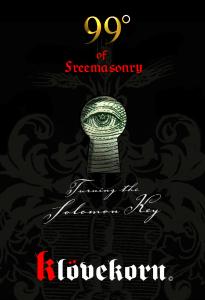Henning A. Kl÷vekorn
99░ OF FREEMASONRY
Turning the Solomon Key
Published by the Author, 2006.
Pp. X, 267.
Price: Australia $37.50 AUD p/p incl.
Price: World $45.00 AUD p/p incl.
ISBN 9781740084161
Available from :
http://www.klovekorn.com

About the Author

A qualified historian, safety professional and environmentalist, Henning Klovekorn is a national quality, safety and environment manager for a manufacturing business in the wine industry.
He has held membership within a diverse range of Masonic jurisdictions and obediences. Amongst his Masonic qualifications, he has also reached the Royal Purple degree of the IOOF. Henning Klovekorn has visited Masonic Lodges and ancient relics throughout the world to gain an exceptional understanding of International Masonic symbolism and traditions.
Henning Klovekorn was inspired to write a book on Freemasonry which differed to existing publications. The 99 degrees of Freemasonry provides a studiously researched analysis of the ancient fraternity, providing new insights into the origin of the Craft and the progressive Masonic movements of the world .
|
Preface
by the Author
The world's largest, most influential and enduring fraternal
society is that of the Freemasons. Spaning many centuries,
their initiatory rites, traditions and principles have made a
significant impact both on the individuals who have frequented
its temples and to society at large.
This book aims to provide a historical and analytical account of
this secretive and influential fraternity, without presenting radical
or fabricated conspiracy theories, with which the market has been
flooded over past years. In the shadow of the inspirational Da
Vinci Code, and its sequel The Solomon Key, this publication is
fitting for the time, as it answers many questions raised by such
works.
Masonic organisations have existed in varying forms since
the earliest periods of human civilisation. The Masonic Orders
of Egypt, the Roman Colleges of Builders, the Military Knights
Templar, to the philanthropic Masonic lodges of today; the effects
of Masonic philosophy have altered and stimulated the progress
of society, wherever its principles could reach. Freemasonry
also affected many ancillary movements, both rivals and related
orders such as the Order of Illumminati, the Orange Institution, the
Druids and the Thule Society.
This work serves to introduce the reader to the history,
organisation, rites and symbolism of Freemasonry. Many will find
themselves pondering on the true essence of Masonry and why,
in effect, they themselves should consider joining the fraternity
or supporting its principles.
Freemasonry is a champion of universal humanity. It
teaches and inculcates common human values such as courage,
compassion, honesty, honour, humility, integrity, sacrifice and
loyalty. It is the enemy of spiritual tyranny, theological slavery
and intolerance. It is the great shining light of truth, in the vast
sea of ignorance.
Ultimately, Freemasonry is an order of peace, morality,
philosophy and enlightenment. It has no religious dogma, no
absolutism, offers no particular salvation or redemption, but
unites people of all races, creeds, religions and cultures for
the common good. It is not a competitor of religion. It is not a
political party. It is not a religion itself, nor does it project its will
and dogma onto others, but ensures that entry into its portals is
neither coerced nor petitioned, but by free will.
It appeals in its membership the inculcation of moral
leadership, not via the threat of physical or spiritual punishment,
but on the basis of human good and intrinsic values. There are
no idols, only heroes, no superstitions, but principles based on
common morality and universal science. The craft is a fraternity
of builders, builders of a greater humanity, in the temple of
universal brotherhood, with tolerance as the ultimate common
thread and the great virtues as its driving force.
|



